In today’s global landscape, the environmental impact of industry activities has become a pressing concern, particularly with regard to carbon emissions. Industries across sectors, including transport, events, and even celebrity engagements, contribute significantly to carbon footprints, amplifying the urgency for sustainable practices.
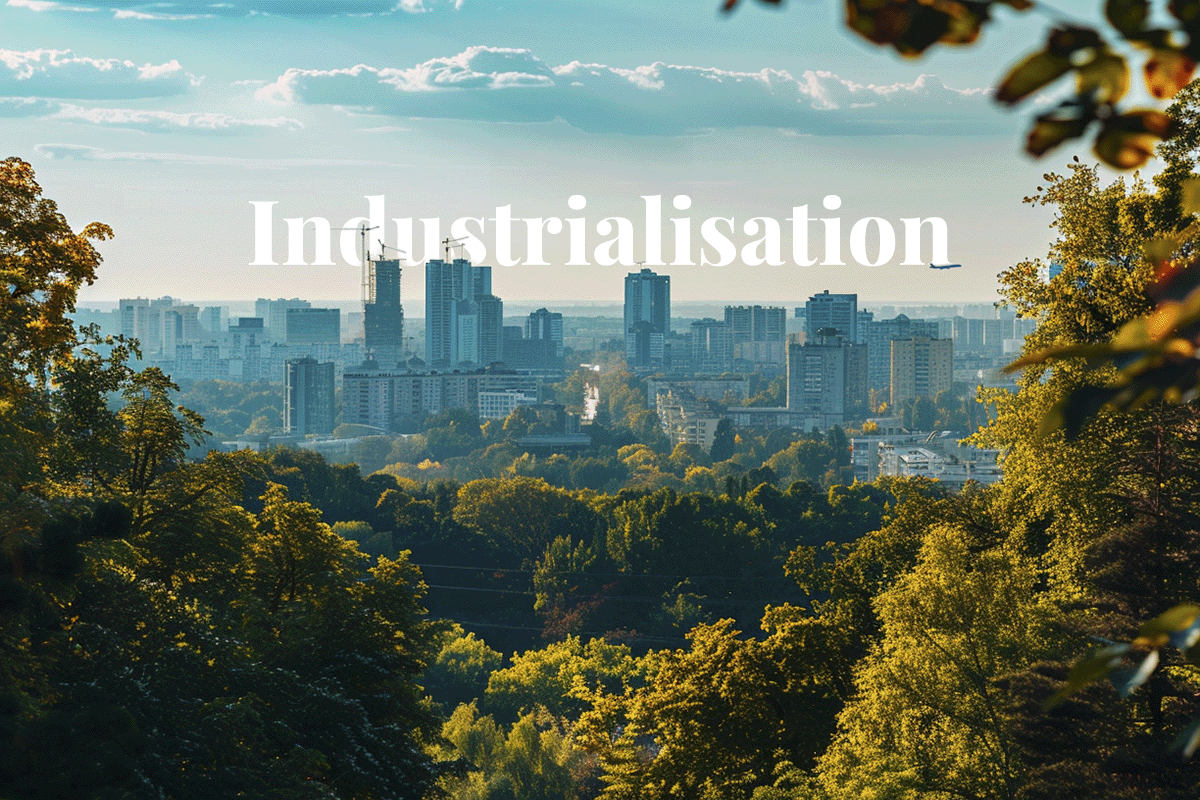 Landscape view of a big city. AI generated picture.
Landscape view of a big city. AI generated picture.
Industrialisation, while propelling economic growth, has concurrently accelerated carbon emissions, leading to profound consequences on the planet. The importance of addressing carbon footprints spans across diverse sectors, each playing a distinctive role in the carbon emissions narrative. From the transportation industry’s pivotal role in global emissions to the carbon footprint associated with hosting events and even the ecological impact of celebrity activities, understanding and mitigating these footprints have become critical imperatives.
Read more: How do carbon footprints work?
As we delve into the intricacies of how these industries are actively embracing sustainable practices, a key focus will be on the role of carbon units (also known as carbon credits). Carbon units emerge as a transformative tool, enabling industries to compensate for their carbon emissions and pave the way for a more sustainable future.
 Close-up of a local man holding a tree seedling, Hongera Reforestation Project, DGB.
Close-up of a local man holding a tree seedling, Hongera Reforestation Project, DGB.
Transport industry carbon footprints
The transportation sector is the second-largest source of global carbon dioxide (CO2) emissions after energy generation and heating, playing a pivotal role in environmental sustainability. In 2022, the worldwide CO2 emissions stemming from the transportation sector increased by over 250 million metric tonnes, reaching close to 8 gigatonnes—reflecting a 3% rise compared to 2021. Notably, the aviation industry played a significant role in this uptick, driven by the resurgence of air travel, which rebounded to approximately 70% after the pandemic.
In the United States alone, the transportation sector accounts for the largest share of CO2 emissions—totalling 1.7 million mega tonnes in 2021—surpassing the electric power sector and making up two-fifths of domestic emissions from burning fossil fuels. This emphasises the urgency to address transport’s environmental impact as it is a key area to promote global low-carbon development.
Read more: Uncovering the impact of Scope 3 emissions
Achieving alignment with the Net Zero Emissions (NZE) Scenario entails a substantial reduction in transport emissions by approximately 25%, aiming to bring them down to around 6 gigatonnes by 2030, even in anticipation of projected growth in demand for transportation services.
The transport sector does not stop with only large transportation companies. Any company within this sector, from travel and tourism agencies to hotels, have a carbon footprint related to transportation. These companies can also address their carbon footprint and provide opportunities for customers to compensate for their environmental impact. In the travel and tourism sector, some companies, especially those focused on nature, have incorporated carbon offsetting programmes for customers, incorporating carbon compensation into ticket prices.
Start measuring your carbon footprint
Case studies: The transportation industry’s carbon reduction efforts
In response to the escalating environmental challenges, the transportation industry is actively pursuing carbon reduction and compensation strategies. While there are many measures the transport industry can take to reduce its environmental impact, carbon units have notably emerged as a transformative tool in this journey.
DHL
DHL is an international logistics company specialising in international mail, package and freight delivery. It is committed to achieving carbon neutrality by 2050 and aims to reduce its CO2 emissions to 29 million tonnes by 2030, compared to the 33 million tonnes emitted in 2020. DHL plans to invest €7 billion over a decade in emission reduction initiatives. As a pioneer, DHL set the goal of being the first logistics company globally to achieve carbon neutrality by 2050 in 2017. It aligns its strategies with international institutions’ data and targets, emphasising the Paris Agreements and the UN’s Sustainable Development Goals.
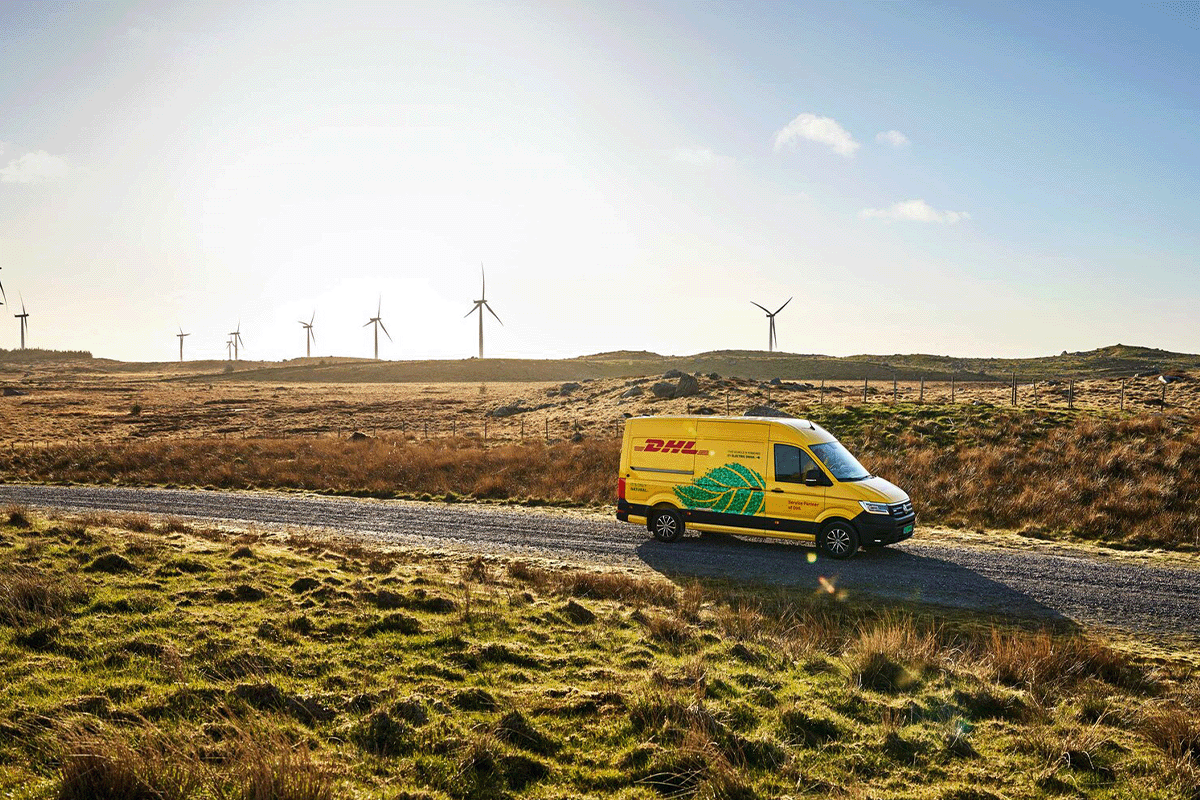 DHL delivery truck, wind turbines in the background. Source: www.dhl.com
DHL delivery truck, wind turbines in the background. Source: www.dhl.com
A key aspect of DHL’s carbon management involves offset projects, which it considers a central pillar. They engage in voluntary offset projects in emerging countries, addressing renewable energy, waste management, and household devices. Notably, DHL focuses on Voluntary Emission Reduction (VER) credits/units, adhering to the Gold Standard. For instance, the Lesotho offset project, an initiative that won the Energy Globe Award in 2018, provided 28,654 credits in metric tonnes of CO2 equivalent. DHL also purchases credits from projects like the 122,140 credits of a landfill gas project in Chile.
World Expeditions
World Expeditions ensures that all its trips are 100% carbon compensated, supporting renewable energy and reforestation projects worldwide. Travellers have the option to go further by compensating for the carbon emissions of their air travel. The cost of carbon compensation is absorbed by World Expeditions and not passed on to travellers.
 Aerial view of Kenya’s nature. AI generated picture.
Aerial view of Kenya’s nature. AI generated picture.
The company calculates trip emissions and purchases carbon units from projects that aid communities in shifting to renewable energy while also contributing to forest protection and regeneration. Travellers indirectly benefit the environment, communities, and economies at no extra cost. Projects include supporting a wind farm in Vietnam, a conservation project in Australia, a habitat protection initiative in Zimbabwe, and a hydropower plant in China. Aligned with UN Sustainable Development Goals, these projects address poverty, clean water, sanitation, economic growth, and more. The carbon units invested in these projects support initiatives benefiting local communities and biodiversity.
Spirit of Japan Travel
Spirit of Japan Travel compensates for your travel carbon footprint, this includes emissions associated with energy for its office, transportation provided for travellers and guides, and accommodations. It calculates tourists’ carbon footprints and compensates for such footprints on their behalf by investing in tree planting and sea turtle conservation in Japan.
 View of Chidorigafuchi Park, Mount Fuji in the background. AI generated picture.
View of Chidorigafuchi Park, Mount Fuji in the background. AI generated picture.
These case studies showcase instances where companies in the transportation sector have successfully compensated for their or their clients’ carbon emissions through the utilisation of carbon units. These efforts demonstrate a commitment to sustainability and contribute to a global movement toward a more eco-friendly and carbon-neutral transportation landscape, emphasising the importance of carbon compensation.
Event industry carbon footprints
Understanding the environmental impact of events is crucial for sustainable practices and reducing global emissions. The events industry collectively contributes up to 10% of worldwide carbon emissions—that is equal to all the carbon emissions of the United States! This substantial environmental impact stems from various factors, including the materials employed, energy consumption, and transportation needed for attendees to reach the event venue. This figure will also increase as the trillion-dollar events industry is expected to grow 11.2% for this decade. The resultant carbon footprint is considerable, highlighting the industry’s role in global emissions.
Read more: The power of sustainability: Why investing in sustainability drives faster company growth
Events, encompassing production, transportation, and waste, exert a significant environmental impact. This impact also does not only extend to major sporting events or music festivals. Research shows that the travel-induced carbon footprint of international conferences surpasses 2,000 tonnes of CO2—equivalent to the yearly emissions of around 270 UK citizens. The University of Freiburg found that each conference attendee contributes 0.5 to 1.5 tonnes of CO2 equivalents during a three-day conference, underscoring the substantial impact of event-related travel.
The environmental challenges persist in music festivals, as seen with Glastonbury generating 2,000 tonnes of waste in a single weekend. An analysis of Coachella reveals that 80% of the festival’s carbon emissions originate from attendees’ travels. This stark figure highlights the need for substantial solutions to reduce the environmental footprint of events.
The Super Bowl, a prominent event in American sports, has a notable environmental impact extending beyond the game itself. Surprisingly, this footprint is not predominantly linked to travel or the event’s energy consumption but is substantially influenced by Super Bowl advertising. The global football industry, emitting over 30 million tonnes of CO2 annually, is about equal to Denmark’s yearly emissions. The immense viewership of major events like the Super Bowl, exceeding 99 million last year, highlights the necessity for organisations to assess the environmental impact of large-scale sporting occasions and other significant events.
Estimates indicate that major sports leagues generate approximately 35,000 tonnes of CO2 annually, encompassing fan emissions alone. Beyond individual emissions, the energy used to power stadiums, resource-intensive field maintenance, and the sale of consumables at games also contribute significantly to the environmental impact. However, the most substantial contributor to the Super Bowl’s carbon footprint is digital advertising.
Read more: The carbon footprint of the Super Bowl
In 2021, Super Bowl ads emitted as much CO2 as 100,000 Americans, totalling around 2 million tonnes CO2. Data from iSpot.tv shows that 56 advertisers with 67 spots created 6.3 billion TV ad impressions, 26 million online views, and 64 billion social impressions. Data shows that 1 million ad impressions equal 1 tonne of CO2. This also equals 1 round trip from Boston to London per passenger, charging 121,000 smartphones, or using 2.4 million plastic straws.
Meeting the Paris Agreement climate target necessitates global per capita emissions of 2.5 tonnes annually by 2030, emphasising the pressing need for decarbonisation and compensation solutions in the event industry.
Case studies: Events implementing sustainable practices and carbon compensation
Despite the challenges, there are success stories within the events industry showcasing the positive outcomes of sustainable practices. Some events have successfully implemented carbon unit programmes, supporting nature-based projects and community initiatives. These success stories inspire others in the industry to adopt similar sustainable practices and contribute to a more environmentally responsible future.
Radisson Hotels
The Radisson Hotel Group automatically offsets the carbon footprint of every meeting and event hosted at their global hotels, making them 100% carbon neutral without any cost to the organisers. This initiative aligns with environmental best practices, focusing on projects that reduce emissions and create positive social impacts. Since the launch, Radisson Meetings have successfully offset 38,300 tonnes of CO₂, equivalent to removing 6,500 cars from the road.
Radisson Meetings actively supports six projects across Europe, the Middle East, Africa, Asia Pacific, and the Americas, all certified to the Gold Standard or Verified Carbon Standard. These projects not only benefit local communities and the environment but also contribute to the United Nations’ Sustainable Development Goals.
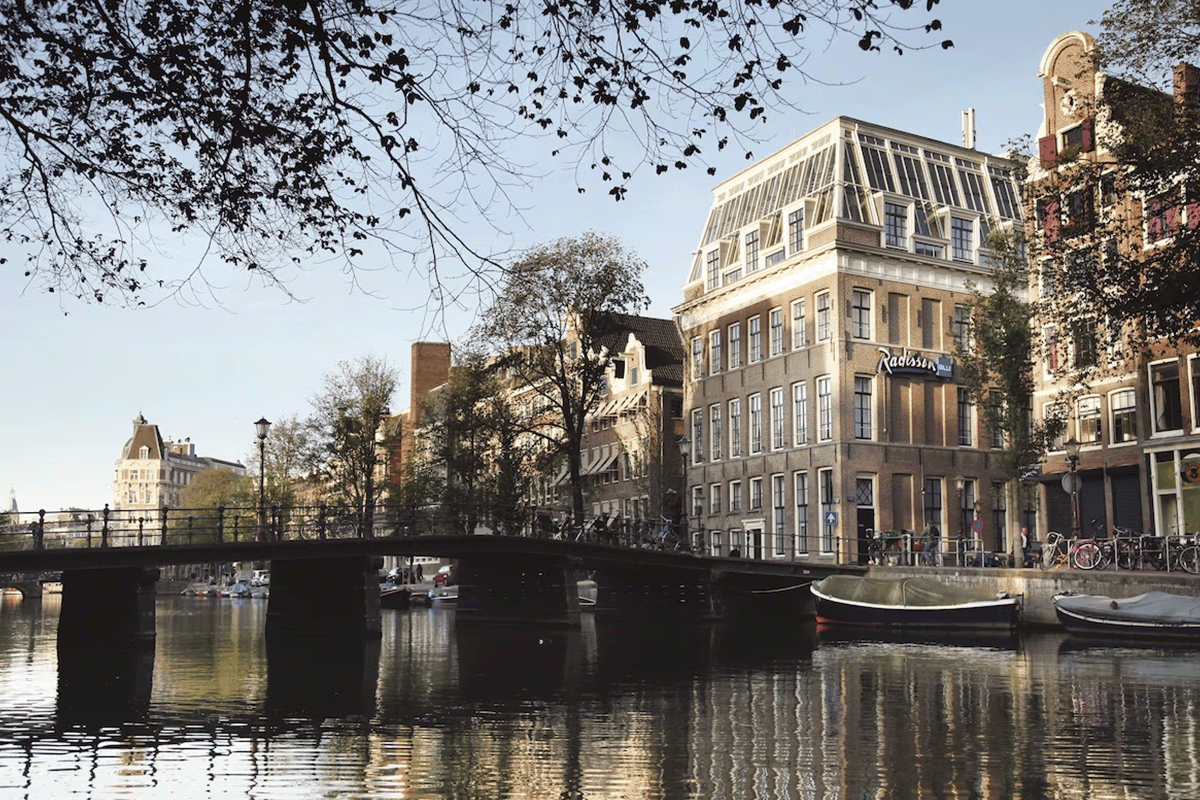 View of the Radisson Hotel in Amsterdam. Source: www.radissonhotels.com
View of the Radisson Hotel in Amsterdam. Source: www.radissonhotels.com
Committed to environmental responsibility, the Radisson Hotel Group aims to reduce its carbon and water footprint by 30% by 2025. This commitment involves adhering to science-based emissions reduction targets, eliminating single-use plastics, and championing best practices in water stewardship and responsible consumption behaviours. Notably, in 2020, 447 hotels, constituting 79% of properties across Europe, the Middle East, and Africa, received an ecolabel in recognition of their sustainable practices.
Formula 1
Formula 1 aims for carbon neutrality by 2030, addressing its 256,551-tonne carbon footprint. In 2019, emissions mainly from logistics (45%) and travel-related activities (27.7%) contributed significantly to its impact. F1 aims to achieve carbon neutrality through a combination of strategies, including compensating for their emissions through tree planting carbon reduction projects.
 F1 race track. Source: www.formula1.com
F1 race track. Source: www.formula1.com
Its objectives include implementing credible biological and technical carbon sequestration projects and achieving a positive race impact by 2025. Community engagement is also emphasised, providing opportunities for local involvement and causes.
FIFA
FIFA is the largest single-sport competition globally, with a substantial carbon footprint. The FIFA World Cup Qatar 2022™ was attended by over a million spectators and engaged billions worldwide. FIFA, aiming to strengthen its focus on sustainability, joined the UN Sports for Climate Action Framework in 2016, aligning with the Paris Agreement’s goals.
In the past decade, FIFA intensified its environmental initiatives, addressing environmental harm, waste management, recycling, sustainable construction, and procurement. Specifically, for the Qatar 2022 World Cup, FIFA is committed to measuring, reducing, and compensating for CO₂ emissions. This commitment extends to previous tournaments like Brazil 2014 and Russia 2018 and will continue for the upcoming FIFA Women’s World Cup Australia & New Zealand 2023™.
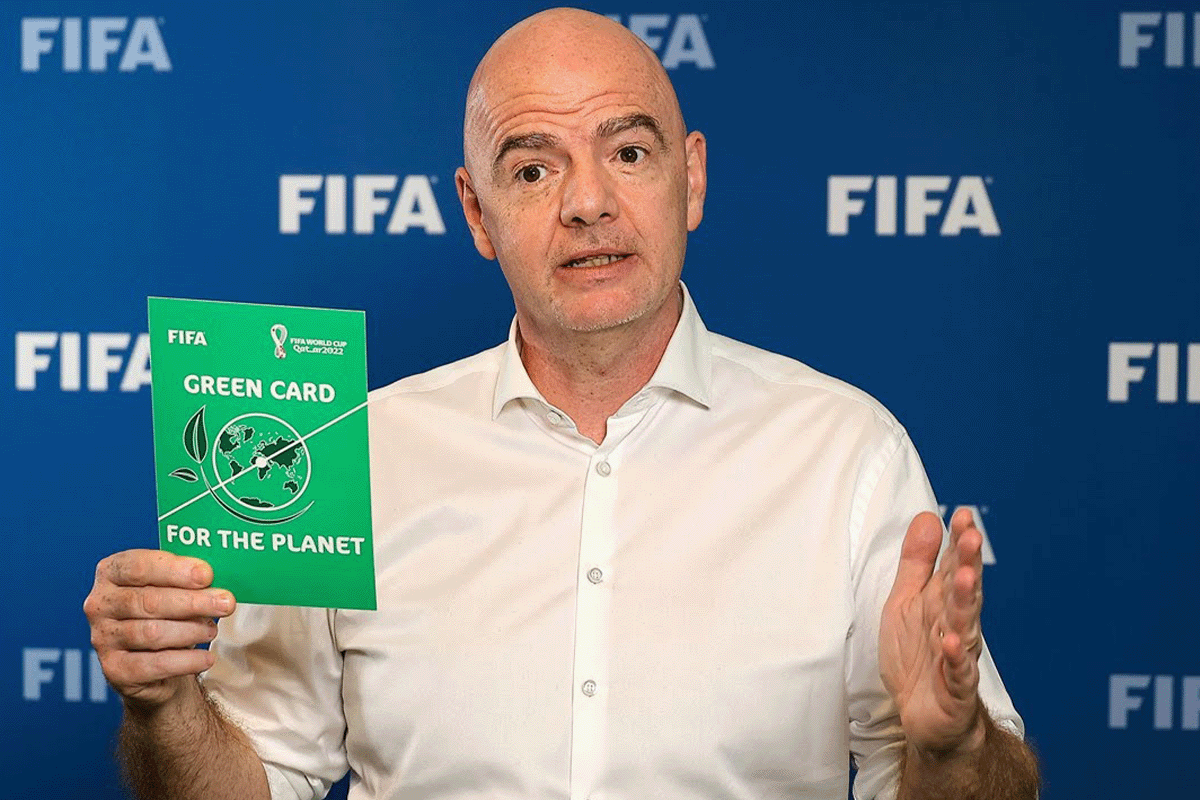 FIFA President, Gianni Infantino, holding Green Card for the Planet. Source: www.fifa.com
FIFA President, Gianni Infantino, holding Green Card for the Planet. Source: www.fifa.com
These examples highlight how the events industry is increasingly focussing on sustainability, with carbon compensation as a key tool being used. These efforts and their support of carbon projects demonstrate the importance of carbon offsetting in reaching global net zero goals.
Celebrity carbon footprints
Celebrities often lead extravagant lifestyles, contributing to significant carbon footprints. In 2023, 200 celebrities and tycoons generated a staggering 415,518 tonnes of CO₂ during 44,739 private jet trips, equivalent to the emissions of approximately 40,000 Britons in a typical year, according to a study by The Guardian.
While air travel is recognised as an environmentally unfriendly mode of transportation due to less efficient emissions per mile, the impact is somewhat mitigated on crowded passenger flights. However, the real environmental concern lies with private jet travel, notably favoured by celebrities.
Start measuring your carbon footprint
Private jets exhibit the worst emissions per passenger ratio, with celebrities emitting an average of 3,376 tonnes of CO₂ in their private jet usage in 2022, a striking 482.37 times more than the average person’s annual emissions. Notable offenders include Taylor Swift, Jay-Z, Kim Kardashian, Floyd Mayweather, Mark Wahlberg, Oprah Winfrey, and Travis Scott. The data also underscores that only 15% of the population takes 70% of flights annually, revealing the disproportionate carbon footprint associated with celebrity private jet use.
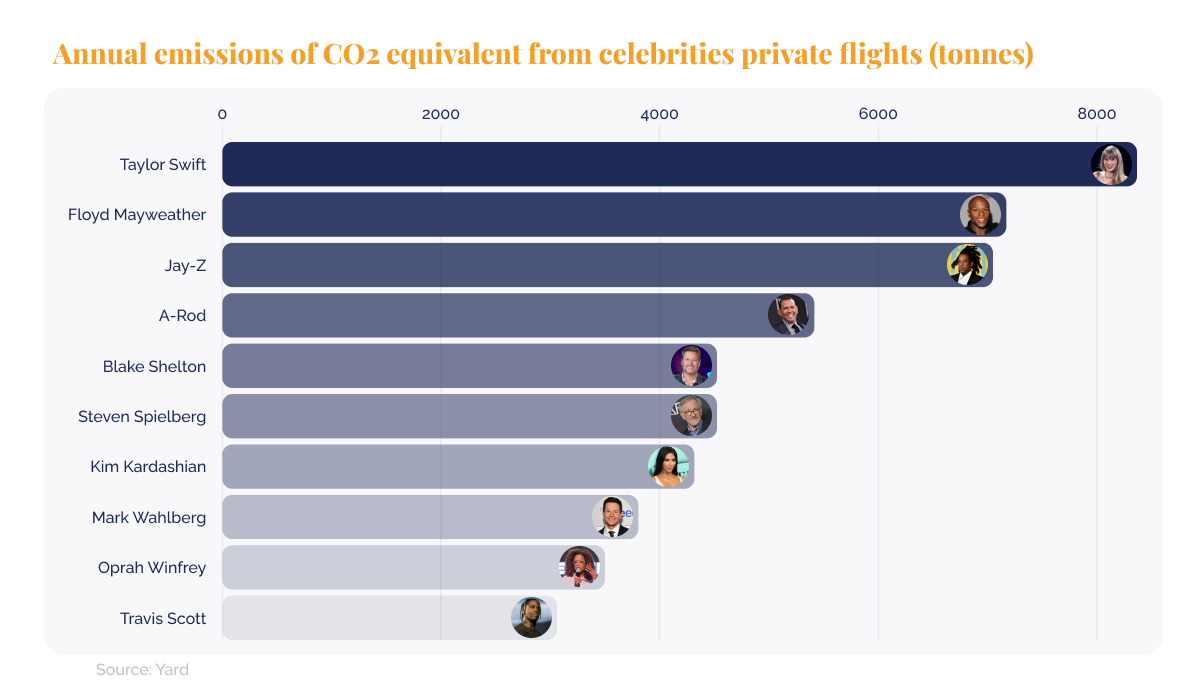 Illustration showing annual emissions of CO2 equivalent from celebrities’ private flights (in tonnes).
Illustration showing annual emissions of CO2 equivalent from celebrities’ private flights (in tonnes).
Case studies: Celebrity initiatives towards carbon mitigation and environmental restoration
Despite their lavish lifestyles, some celebrities actively work to reduce their carbon impact.
Taylor Swift
Taylor Swift, the renowned pop icon, has taken steps to compensate for emissions from her private jet, addressing her substantial carbon footprint. In 2022, Swift, identified as the most carbon-polluting celebrity, is proactively reducing her environmental impact. Her flight emissions totalled 8,293 tonnes for the year, surpassing the average person’s annual emissions by over 1,100 times.
In response to increasing environmental awareness, Swift emphasises her dedication to sustainability. Notably, her team asserts that she lends her jet to others, and she has gone above and beyond by purchasing double the required carbon units to compensate for her tour travel, showcasing her commitment to eco-friendly practices.
Read more: Taylor Swift’s eco-tune: addressing her high carbon footprint
Dave Matthews Band
The Grammy-winning UN Environment Goodwill Ambassadors Dave Matthews Band, through their Bama Green Project, is at the forefront of sustainable touring. Notably, they offset emissions from air travel and hotels by supporting carbon reduction projects like tree plantings. The Dave Matthews Band is committed to environmental stewardship and pledged to plant another million trees. Fans can contribute by adding an optional $2 to their ticket price.
 Dave Matthews Band poster promoting tree planting. Source: www.davematthewsband.com
Dave Matthews Band poster promoting tree planting. Source: www.davematthewsband.com
In a commitment to efficiency, the band partnered with UPS to develop greener transportation methods for their equipment. Beyond their individual efforts, the band established Green Music Group, a significant coalition comprising musicians, fans, and industry leaders like Linkin Park, Sheryl Crow, and Willie Nelson. Through their multifaceted approach, the band strives to lead by example and inspire positive environmental practices in the music community.
Read more: Reforestation: 10 amazing benefits of planting trees
Drake
Drake is actively contributing to environmental sustainability, focusing on reducing and compensating for his carbon footprint. In his efforts, Drake is engaging in initiatives to calculate and mitigate his carbon impact from travel and events. This includes devising plans to reduce his environmental footprint, with particular emphasis on reforestation projects. Drake’s commitment aligns with a broader vision for environmental stewardship, aiming to motivate and create widespread awareness of sustainable practices.
These artist case studies highlight how individuals can also reduce their carbon footprint and make a positive impact through carbon compensation. Their efforts and support of carbon projects demonstrate the importance of carbon offsetting and environmental preservation.
Read more: The importance of carbon offsetting in achieving net zero
Carbon units as a solution
Carbon units (carbon credits) are a crucial component of environmental sustainability, designed to mitigate environmental harm and restore nature. These units represent a quantified reduction, removal, or avoidance of CO₂ in the atmosphere. They are used by individuals, organisations, and industries to compensate for their carbon footprint.
Nature-based solutions (NBS) play a pivotal role in carbon strategies. NBS utilises the inherent ability of nature, such as forests, oceans, and soil, to absorb and store carbon naturally. These solutions contribute to environmental crises mitigation by harnessing the power of ecosystems. Key benefits of nature-based carbon units include:
- Environmental restoration: NBS, through efforts like reforestation, helps to restore the environment by creating vital habitats, boosting biodiversity, and conserving ecosystems.
- Community benefits: Landholders, farmers, and communities benefit from participating in nature-based carbon projects, fostering community involvement, job creation, and sustainable practices.
- Natural climate solutions (NCS): NCS can provide over one-third of the necessary climate mitigation by 2030, demonstrating their significant impact on reducing carbon emissions.
- Cost-effectiveness: Nature-based carbon units offer a cost-effective approach to combating environmental harm, providing an efficient means of reducing environmental impacts.
 Close-up of tree seedlings, Hongera Reforestation Project, DGB.
Close-up of tree seedlings, Hongera Reforestation Project, DGB.
DGB Group’s large-scale nature-based projects offer a multitude of advantages in addition to the carbon they remove from the atmosphere. Our projects include reforestation, afforestation, community-based agroforestry, and energy-efficient cookstoves, all combatting deforestation, restoring biodiversity, and empowering communities through job creation, training, and additional income.
Read more: How nature-based projects contribute to net-zero goals
Carbon units extend their benefits beyond individual efforts, making a significant impact on various industries, including transportation, events, and celebrities.
- Transportation industry: Carbon units enable the transportation sector to offset emissions from vehicles and logistics operations, contributing to a more sustainable industry.
- Events industry: Carbon credits support the events industry in organising eco-friendly gatherings by compensating for the carbon footprint generated during events like concerts and conferences.
- Celebrities: Celebrities utilise carbon units to compensate for their personal carbon footprint, demonstrating environmental responsibility and promoting sustainable practices in the public eye.
Carbon units, especially those rooted in nature-based solutions, therefore offer a versatile and effective tool for combating environmental impacts across various sectors, fostering a more sustainable and environmentally conscious future.
So, if you are wondering how to reduce your carbon footprint, start by measuring your carbon footprint and then compensate for your past or irreducible emissions with carbon units from nature-based projects. This is a great step towards becoming sustainable and making a positive environmental impact.
Start measuring your carbon footprint
DGB Group—helping you to become more sustainable
The imperative shift towards environmental responsibility in industries such as transportation, events, and even celebrity lifestyles underscores the urgency of reducing carbon footprints. And today, many organisations and individuals are already voluntarily disclosing how they are assessing, measuring and managing carbon emissions and related risks, embracing carbon units, particularly those rooted in nature-based solutions, as a powerful strategy.
DGB Group is your ideal partner in this sustainability journey. Through our verified top-quality carbon units, we enable industries and individuals to compensate for emissions, fostering a more sustainable and eco-friendly ecosystem. By providing a tangible pathway for businesses and individuals to address their environmental impact, DGB helps restore nature and create a greener tomorrow.
As industries and public figures increasingly recognise the significance of mitigating their environmental impact, carbon compensation through our carbon units becomes instrumental in driving positive environmental outcomes. Through our dedication to nature-restoration initiatives, DGB creates a harmonious balance between industrial growth and ecological preservation. By measuring and addressing your carbon footprint, you can help build a more sustainable world for future generations.
Explore how DGB’s carbon units can reduce your carbon footprint
- SEO Powered Content & PR Distribution. Get Amplified Today.
- PlatoData.Network Vertical Generative Ai. Empower Yourself. Access Here.
- PlatoAiStream. Web3 Intelligence. Knowledge Amplified. Access Here.
- PlatoESG. Carbon, CleanTech, Energy, Environment, Solar, Waste Management. Access Here.
- PlatoHealth. Biotech and Clinical Trials Intelligence. Access Here.
- Source: https://www.green.earth/blog/industry-carbon-footprints-transport-events-and-celebrities



